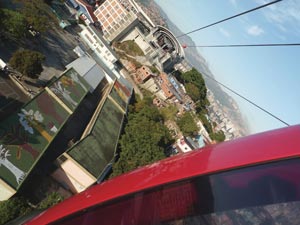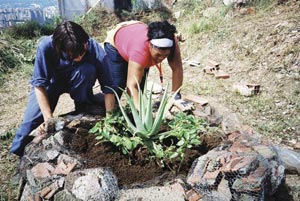Contemporary artistic practices extendtheir bounds to reach out spaces beyond those recognized as elements of visual arts. Their repertoires include other categories such as personal experiences and sharing actions, as must-have conditions to develop artworks. After having bypassed basic conditions understood as spirit and materia, we find awareness in terms of the social, the need to get involved with the “other” makes up the art=life formula, and that’s how they gain spaces to obtain experiences that increase the infinite field of their performances.
We are witnessing times when art lacks of the prominence that previously fell on the “work in process”, where the idea doesn’t seem to be important for the artists, since they focus their efforts on including new situations such as interventions in communities, called to join the author. This is where the artwork loses its finite condition, and appears making up constellations, drawing lines to build a hank of virtual threads added to an endless number of results that are merged into multiple networks to create universes. These artists are intended to edit collective stories; they are a sort of art missionaries for new ages, who take other people’s life as an important component of their own lives and, therefore, their art. This is how nomenclature have evolved, by moving the concept from fine arts to plastic arts, from these to visual arts and now to contemporary artistic practices. It’s all about spaces of experience, coexistence, that get into the reality by taking social grounds, where they spread and cultivate a new meaningful spirit to let arts in. What was previously limited to be just an object –and the time it took– is no longer important for these authors whose approach is after anonymity in order to promote the development and growth of a collective work.
 Natalya Crichley is part of this crusade. She has travelled through Venezuela with her outdoor work that has made possible the creation of a personal inventory of urban landscapes reconstruction. It’s all about large-format drawings and paintings directly created from the environment, the perfect excuse to develop multiple creative communitarian associations. When she moved from her homeland, England, to Venezuela, she lived in Puerto Ordaz, Bolivar state. Natalya was, in that place, an amazed witness and visual chronicler of the birth of industries; she lived there for several years and felt, along with rest of the people in the area, the meaning and consequences of the rushed transition from a rural condition to the urban one. On these first impressions, she says: "the relation between myth and reality is pretty free, a constant giving and taking among different situations, thus creating unexpected connections and relations". She found in this city the bases for her research on coexistence and landscape.
Natalya Crichley is part of this crusade. She has travelled through Venezuela with her outdoor work that has made possible the creation of a personal inventory of urban landscapes reconstruction. It’s all about large-format drawings and paintings directly created from the environment, the perfect excuse to develop multiple creative communitarian associations. When she moved from her homeland, England, to Venezuela, she lived in Puerto Ordaz, Bolivar state. Natalya was, in that place, an amazed witness and visual chronicler of the birth of industries; she lived there for several years and felt, along with rest of the people in the area, the meaning and consequences of the rushed transition from a rural condition to the urban one. On these first impressions, she says: "the relation between myth and reality is pretty free, a constant giving and taking among different situations, thus creating unexpected connections and relations". She found in this city the bases for her research on coexistence and landscape.
Afterwards, she moved to the capital and took it as a watching center, which allowed her to participate in the social-political development lived by this country. She mindfully studies the complex and meaningful space, creates an approach personal map, and thinks: "San Agustín[i] isn’t a landscape with its Metrocable, it’s not so close and doesn’t have the obvious charm of Palos Grandes’ modernist architecture, but it has been a fascinating contrast to that piece of friendly city where I live and work. The informal and oddly invisible city (we try not to see it) that grew up along with the expansionist insanity of the oil boom, is still kind of rejected and distressing for many people. There are reasons for this reality, since violence is suffered there in unthinkable ways at middle class residences. From San Agustin, a hill located in the core of Caracas’ valley, with incredible views from Petare to Los Teques, Avila and Cementerio, you get a clear image of the true proportions of this “informal” city that surrounds and shelters the 'formal' one. It’s like watching the city different from what we have gotten used to perceiving in the avenues; the extension of neighborhoods can be admired, although the most accurate view would be from the air so the convulsions of Petare, Catia and Antimano hills can be seen."
Our artist joins the daily life in the neighborhood to promote meetings and work rounds. There are communitarian leaders that help her and make the information gathering activity easier in terms of people customs, thus generating confidence to obtain richer communication within the collective. One of the results of these exchanges is the project to recovery a space for cultural development: La Ceiba. It’s a huge tree located in the center of a terrain where houses are going to be built. Several years have passed and the process is frozen, the idea is to promote cultural and recreational activities at the shade of the tree that names and shelters the collective initiative. Workshops on animation, literature and recycling, ecology, family orientation. Each member contributes with knowledge and proposes alternatives to improve the neighborhood. Natalya heads the group of children and teenagers that is working on the giant mural on the school roof. Passengers traveling on the Metrocable observe from the air the development of the work. Beyond the learning that accompanies team work, the stimulation and motivation to think and do in collective carry photography and video lessons. They are presently "hunters and collectors" of images related to La Ceiba cultural collective. San Agustin is currently a breeding ground of ideas and Natalya Critchley will be there to watch them grow as high and leafy as the Ceiba.
 This experience and its results were the motives to suggest Natalya Critchley to prepare a project and show it to the curators at Wifredo Lam Center, within the framework of the 11th Havana Biennial. The theme:Artistic Practices and Social Imaginaries, motivated the artist to propose workshops on animation and video with Cuban children and teenagers. These activities were aimed at sharing audiovisual information on the experience at San Agustin neighborhood in Caracas, as well as achievements obtained in similar workshops. Besides, Natalya developed a program for basic training on short film production in order to encourage children to make a documentary that would be handed to the group at La Ceiba.
This experience and its results were the motives to suggest Natalya Critchley to prepare a project and show it to the curators at Wifredo Lam Center, within the framework of the 11th Havana Biennial. The theme:Artistic Practices and Social Imaginaries, motivated the artist to propose workshops on animation and video with Cuban children and teenagers. These activities were aimed at sharing audiovisual information on the experience at San Agustin neighborhood in Caracas, as well as achievements obtained in similar workshops. Besides, Natalya developed a program for basic training on short film production in order to encourage children to make a documentary that would be handed to the group at La Ceiba.
The objective was fulfilled, the social imaginaries are growing in number and creating new constellations…
Related Publications

How Harumi Yamaguchi invented the modern woman in Japan
March 16, 2022












